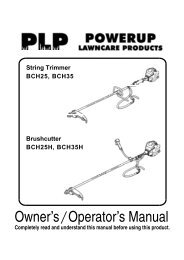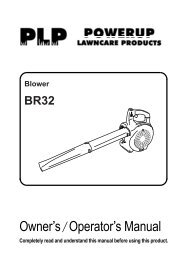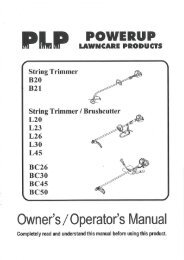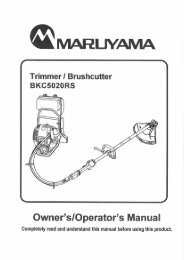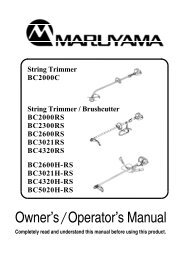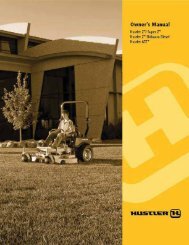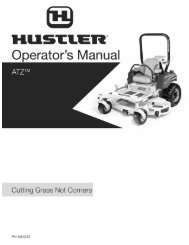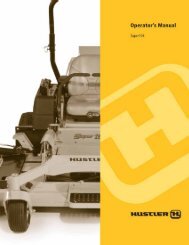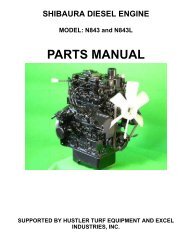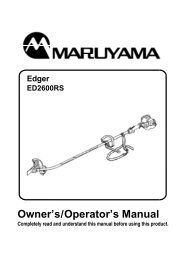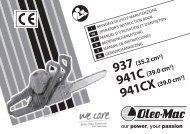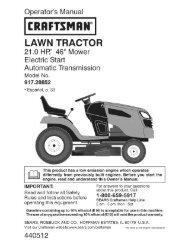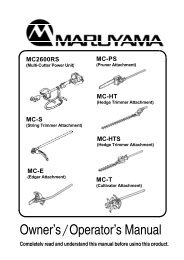Download the Fastrack Super Duty Owner's Manual 48/54/60
Download the Fastrack Super Duty Owner's Manual 48/54/60
Download the Fastrack Super Duty Owner's Manual 48/54/60
Create successful ePaper yourself
Turn your PDF publications into a flip-book with our unique Google optimized e-Paper software.
Figure 4-7<br />
Safety filter<br />
Recommended service procedure<br />
1. Release clamps and remove element. Clean <strong>the</strong> canister<br />
with a damp cloth.<br />
2. Before installing a new element, inspect it by placing a<br />
bright light inside and rotating <strong>the</strong> element slowly,<br />
looking for any holes or tears in <strong>the</strong> paper. Also check<br />
gaskets for cuts or tears. Do not attempt to use a damaged<br />
element which will allow abrasive particles to enter <strong>the</strong><br />
engine.<br />
3. Reinstall <strong>the</strong> dust cup. Make sure it seals all <strong>the</strong> way<br />
around <strong>the</strong> air cleaner body, <strong>the</strong>n tighten <strong>the</strong> clamps.<br />
Figure 4-6<br />
4. Check all fittings and clamps periodically for tightness<br />
and inspect hoses for holes or cracks.<br />
5. Periodically check <strong>the</strong> intake hose for signs of ingested<br />
dust. Locate and repair <strong>the</strong> source of ingested dirt.<br />
6. Never operate <strong>the</strong> machine without an air filter installed.<br />
Overservicing<br />
Overservicing occurs when an air filter element is removed<br />
for cleaning or replacement before it is necessary. Each time <strong>the</strong><br />
filter is removed a small amount of dirt and dust could fall in <strong>the</strong><br />
intake system. This accumulated dirt can cause a dusted engine.<br />
It only takes a few grams of ingested dirt over <strong>the</strong> normal<br />
service life of an engine to cause a dusted engine.<br />
Do not clean <strong>the</strong> element, but replace with a new element<br />
only. Cleaning used air filter elements, through improper<br />
cleaning procedures, can get dust on <strong>the</strong> inside of <strong>the</strong> filter<br />
causing dirt ingestion and engine failure.<br />
It is important to note that whenever an air filter element is<br />
cleaned by any method, <strong>the</strong> person or company performing <strong>the</strong><br />
cleaning assumes responsibility for <strong>the</strong> integrity of <strong>the</strong> filter<br />
from <strong>the</strong>n on. The warranty for air filters expires upon<br />
cleaning or servicing in any manner because <strong>the</strong> condition of<br />
<strong>the</strong> filter after servicing is completely out of <strong>the</strong> filter’s<br />
control. Therefore, on a dust ingested engine failure, <strong>the</strong>re<br />
will be no warranty consideration if <strong>the</strong> air filter element<br />
has been cleaned or serviced in any manner.<br />
A partially dirty air filter element works better than a new<br />
element. Therefore, a dirty filter element is not bad for <strong>the</strong><br />
engine unless it is excessively restricting <strong>the</strong> air flow and engine<br />
performance is affected. The reason is simple. The media in <strong>the</strong><br />
filter must be porous to allow air to pass through it. When dirty<br />
air passes through <strong>the</strong> filter, <strong>the</strong> dirt plugs some of <strong>the</strong> holes in<br />
<strong>the</strong> media and actually acts as part of <strong>the</strong> filter media. When <strong>the</strong><br />
next round of dirt enters, <strong>the</strong> first dirt helps filter out even<br />
smaller particles making <strong>the</strong> filter more efficient at stopping dirt<br />
from entering <strong>the</strong> engine. This is referred to as barrier filtration.<br />
Of course, at some point <strong>the</strong> filter media becomes too clogged<br />
to allow air to pass.<br />
The mowing conditions will determine <strong>the</strong> frequency of air<br />
filter element changing.<br />
General Engine Maintenance<br />
Detailed instructions and recommendations for break-in and<br />
regular maintenance are specified in <strong>the</strong> Engine Owner’s<br />
<strong>Manual</strong>. Please refer to this manual for engine servicing,<br />
lubricating oil levels with quality and viscosity<br />
recommendations, bolt torques, etc. The engine warranty is<br />
backed by <strong>the</strong> manufacturer. Special attention should be paid to<br />
applicable data which will not be duplicated here.<br />
Carbon Canister<br />
Some FasTrak <strong>Super</strong> <strong>Duty</strong> mowers will have a carbon canister<br />
incorporated into <strong>the</strong> fuel system. Figure 4-8<br />
This is a mandatory feature that is required on all mowers<br />
using gasoline engines that are put into operation in California.<br />
These canisters should be replaced every 5 years or if <strong>the</strong>y<br />
become damaged.<br />
Carbon<br />
canister<br />
Figure 4-8<br />
Fuel Evaporation System Filter<br />
Fuel evaporation<br />
system filter<br />
Some FasTrak <strong>Super</strong> <strong>Duty</strong> mowers have a fuel evaporation<br />
system filter. This filter must be checked and replaced every 300<br />
REV E 4-6 <strong>60</strong>2901




